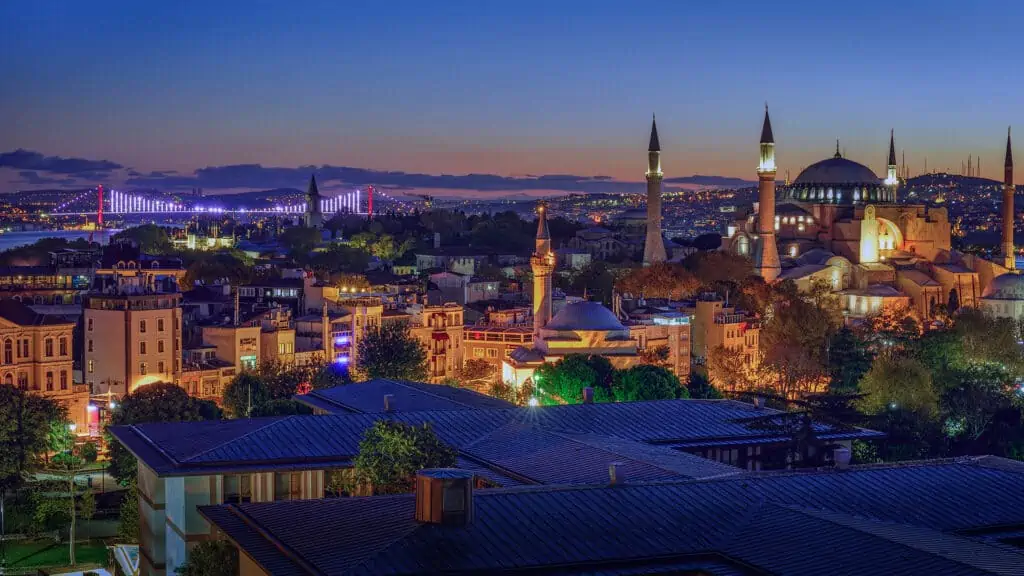There is only one metropolis in the world, which is located on two continents. Being the largest and most populous city (12.8 million inhabitants) of the Turkey, which received the name Istanbul way back in 1930 only. The original name of this city was Byzantium, before the name Constantinople came. Geographically, Istanbul stretches on both sides of the strait between the Mediterranean Sea and the Black Sea, the Bosporus. Istanbul has a very varied and rich history. The architecture of the cityscape combines a mixture of the most diverse historical building styles.
The buildings have characteristics of the most different cultures (Greeks, Romans, Byzantines, Ottomans and Turks). Because of these different architectural styles, Istanbul has a certain uniqueness. Because of these different architectural styles, Istanbul has a certain uniqueness. This has led to the historic Old City being designated a UNESCO Cultural Heritage Site.
The sights are an absolute must for everyone.
• The Blue Mosque – the most beautiful mosque in Istanbul and a landmark
Built in the 17th century by Sultan Ahmet I, this is most famous for its 6 elegant minarets and the beautiful blue tiles inside. In addition, inside the building there are about 29,000 handmade Iznik (ceramic oriental) tiles in the shape of flowers and 200 colorfully patterned windows.
• Galata Bridge and Galata Tower – The Lively Center of Istanbul
This bridge is considered to be one of the most important traffic junctions of Istanbul. However, this location offers much more: delicious street food, on the lower side of the bridge are restaurants with a variety of country specialties on their menu. In the meantime, you can watch the ferries on the Golden Horn and Bosphorus or smoke a Turkish water pipe (the Nargile) in one of the many pubs, bars and cafes to relax.
One of the most beautiful views of the Süleymaniye Mosque and the Egyptian Bazaar is from the Galata Tower. Built way back in the 14th century, this is the most important building preserved from the time of the Genoese colony being within Istanbul.
• Maiden’s Tower
The name Maiden’s Tower comes from one of many legends. Located on a small island at the southern entrance of the Bosphorus, this tower can be easily reached by private boat. Inside, there is a café and a restaurant overlooking the background of the capital. Inside, there is a café and a restaurant overlooking the background of the capital.
• Istanbul Archaeological Museum
This museum, founded as the central archaeological museum of the Ottoman Empire in Constantinople back in 1891, is now the largest and most important archaeological museum in Turkey. The collections contain more than 15,000 archaeological pieces from Mesopotamia and originate from the area of the Ottoman Empire influenced by the diverse cultures of the ancient, medieval and modern times.
• Camlica Hill and the Golden Horn
Located in the Üsküdar district, this hill is located in the Asian part of the city. A beautiful panoramic view of the southern part of the Bosphorus and the estuary of the Golden Horn. The Golden Horn, the river estuary of the streams Alibey and Kâğıthane, is an important urban waterway and is spanned by 5 bridges.
• Beylerbeyi Palace – “Lord of Lords”
As a summer residence and equally a place for entertaining heads of state, this palace was built between 1861 and 1865. It is located on the Asian side of the Bosphorus just north of the first Bosphorus Bridge. This residence was the last place of the deposed Sultan Abdulhamid II, who was under house arrest before his death in 1918. The palace looks most beautiful from the Bosphorus, from where the two bathing pavilions, one for the “Harem”(women only) and the other for the “Selamik” (men only), are best to be seen. One of the most attractive rooms is the reception hall with pool and water fountain. Due to the heat, running water was popular in Ottoman houses for its pleasant sound and cooling effect. For insulation purposes, Egyptian reed mats are used on the floor. The crystal chandeliers and carpets were also of noble origin.
• Chora Church – a marvel of mosaic and fresco art
This church represents one of the most impressive examples of Byzantine mosaic art. Like many of Istanbul’s historic buildings, this sacred building has had a long and turbulent history. Originally built as a Christian church, it was then converted into a mosque by the Ottomans and, after extensive restoration, was used as a museum since 1948. The name comes from the Kariye district and is located near the Edirnekapi city wall above the Golden Horn.
• Suleymaniye Mosque – one of the great mosques in Istanbul
Built inbetween 1550 and 1557 in a very short construction period by the order of Sultan Suleyman the Magnificent, this mosque is an important work of the architect Sinan. It is one of the most magnificent imperial mosques in Istanbul and the Turkey.
• Egyptian Bazaar (Miri Carsisi) – Spice Market
This bazaar, also named Spice Market, is located 100 meters from the south end of Galata Tower. It was built in 1660 by Hatice Turhan Sultan as part of this mosque complex. The name goes back to the goods which were mainly sold here in former times: especially the spices which came from Egypt. The initial financing of this building was also based on the taxes of the imported Egyptian goods.
All in all, Istanbul is a unique city with a glorious past of three successive empires and therefore still has an important role in history.
For charter or aircraft management enquiries, please contact us at .





